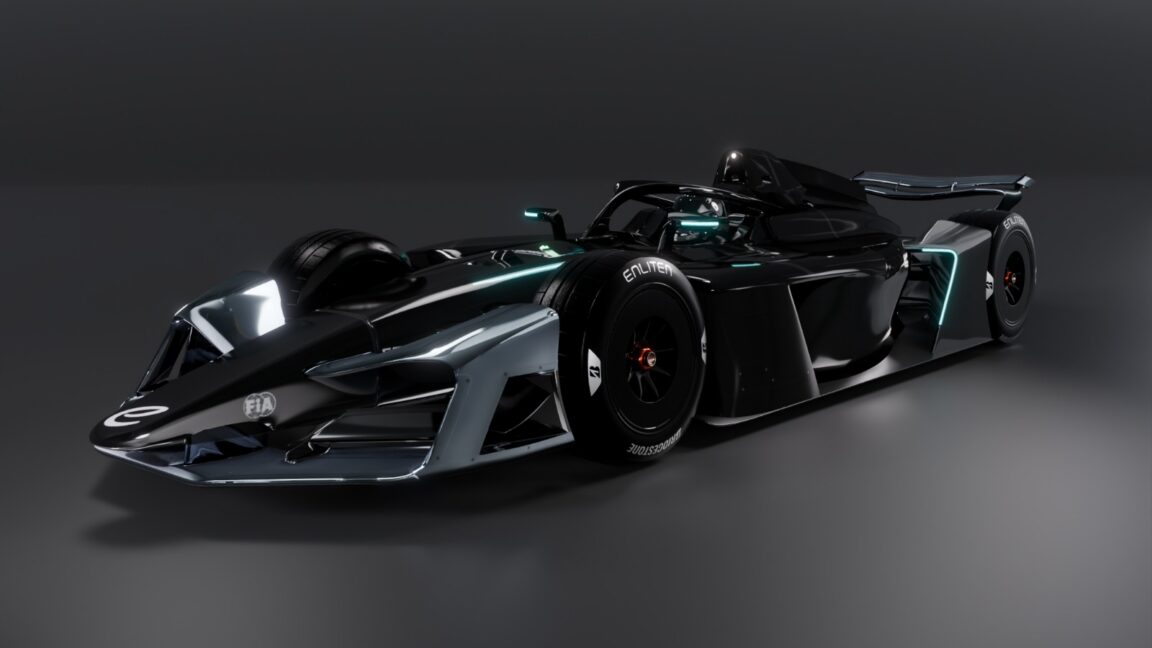Up to 700 kW regen braking, new Bridgestone tires, and it’s even fully recyclable.
Formula E officially revealed its next electric racing car today. At first glance, the Gen4 machine looks similar to machinery of seasons past, but looks are deceiving—it’s “so much more menacing,” according to Formula E CEO Jeff Dodds. The new car is not only longer and wider, it’s far more powerful. The wings and bodywork now generate meaningful aerodynamic downforce. There will be a new tire supplier as Bridgestone returns to single-seat racing. The car is even completely recyclable.
I’m not sure that everyone who attended a Formula E race in its first season would have bet on the sport’s continued existence more than a decade down the line. When the cars took their green flag for the first time in Beijing in 2014, as many people derided it for being too slow or for the mid-race car swaps as praised it for trying something new in the world of motorsport.
Despite that, the racing was mostly entertaining, and it got better with the introduction of the Gen2 car, which made car swapping a thing of the past. Gen3 added more power, then temporary all-wheel drive with the advent of the Gen3 Evo days. That car will continue to race in season 12, which kicks off in Brazil on December 6 and ends in mid-August in London. When season 13 picks up in late 2026, we might see a pretty different kind of Formula E racing.
“It feels like a real moment for us,” said Dodds. The new car will generate 603 hp in race mode, a 50 percent jump compared to the Gen3 Evo. That goes up to 804 hp (600 kW) in attack mode. For context, next year’s F1 cars will generate more power, but only when their batteries are fully charged; if the battery is depleted, that leaves just a 536 hp (400 kW) V6.
Acceleration should be extremely violent thanks to permanent AWD—the first for any single seater in FIA competition, at least for the last few decades. Top speed will be close to double that of the original race car, topping out at 210 mph (337 km/h). Now you can see why the sport decided that aerodynamic grip would be a useful addition.
In fact, there will be two different bodywork configurations, one for high downforce and the other with less. But that doesn’t mean Formula E teams will run out and build wind tunnels, like their F1 counterparts. “There’s significant gains that can be made out of software improvements, efficiency improvements, powertrain developments,” said Dodds, so there’s no incentive to spend lots of money on aero development that would only add fractions of a second.
The biggest opportunity for finding performance improvements may be with traction control and antilock braking systems. Formula E wants its technology to be road-relevant, so such driver aids will be unlimited in the Gen4 era. But efficiency will remain of utmost importance; the cars will still have to regenerate 40 percent of the energy they need to finish the race, as the 55 kWh battery is not sufficient to go flat-out to the end. Happily for the drivers, the new car can regen up to 700 kW of energy under braking.
Finally, the car’s end of life has been considered. The entire race car is entirely recyclable, Formula E says, and it already contains 20 percent recycled content.
So far, the Gen4 car has been put through its paces for more than 5,000 miles (8,000 km), which is more than the mileage of an entire Formula E season, including testing. Now the teams have started to receive their chassis and have started the work of getting to know them and preparing to race them in season 13, all while getting ready to start season 12 next month.
What we won’t know until season 13 gets underway is how the Gen4 era will change the races. With bigger, faster cars, not every Formula E circuit will still be suitable, like London’s very tight Excel Arena track, but with a continued focus on making efficiency count, it’s quite likely we’ll continue to see the same close pack racing as before.
Ars Technica has been separating the signal from the noise for over 25 years. With our unique combination of technical savvy and wide-ranging interest in the technological arts and sciences, Ars is the trusted source in a sea of information. After all, you don’t need to know everything, only what’s important.












